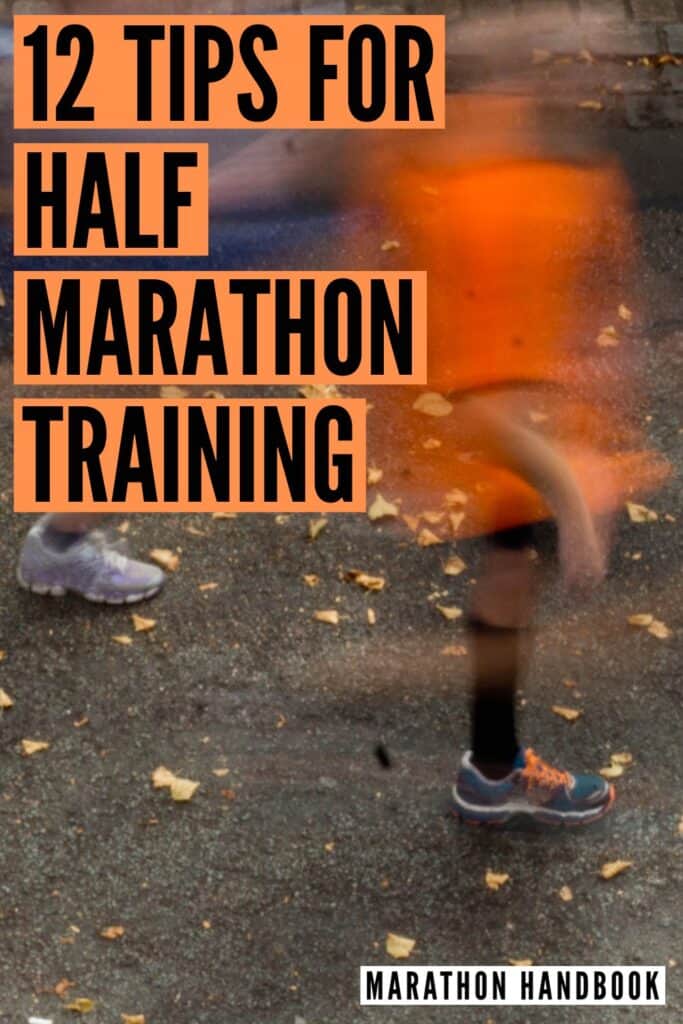Training for a half marathon is an exciting journey that combines physical endurance, mental resilience, and strategic planning.
Whether you’re an experienced runner looking to take on a new challenge or a beginner eager to test your limits by running your first half marathon, proper preparation is key to crossing the finish line happy, healthy, and injury-free.
With an expert training program and our top tips for how to prepare for a half marathon, you will be well on your way to a successful race.

How To Prepare For A Half Marathon
#1: Get High Quality Running Gear
Now is the time to invest in some good running gear.
You’ll want at least two pairs of running shoes to rotate throughout your training. Pick your favorite pair for race day and stick with them.
Whatever you do, don’t try new shoes on race day! Doing so is a recipe for disaster and a miserable half-marathon race.
You also want to invest in a few high-quality clothing items for your long runs and eventual race. Wear them during training sessions to ensure they don’t rub, chafe, or ride up or down.
Check out your local running store to find the best gear for you.
No one wants to run 13.1 miles with unnecessary discomfort they could have avoided!

#2: Give Yourself Adequate Time to Prepare
Ensure that you can dedicate adequate time (number of weeks of training, weekly mileage, and daily workouts) to be truly prepared for race day.
How long does it take to prepare for a half marathon?
It’s key to put together (or find!) a solid training schedule lasting at least 13 weeks, especially if this is your first time training for a half marathon.
This will give your body and mind plenty of time to adjust to the new distance.
Remember, you generally want to add 10% more total miles every week (the 10% rule), so you need the time to build up your mileage slowly. Otherwise, you risk getting burned out or injured.
#3: Vary Your Runs
There are plenty of training plans out there, and you should pick the one that appeals to you the most.
No matter which plan you choose, ensure it includes various types of training runs. These should include interval training, race-pace runs, easy runs, tempo runs, and long runs.
This variety of training day sessions will prepare your body for whatever race day throws at you and ensure that your mind is also prepared for that start line.

#4: Practice Race Day Nutrition
What are the best nutrition strategies for half marathon training?
This is one of those half marathon tips that gets sorely overlooked, especially by new runners.
Fueling yourself on race day is an integral part of success. Lisa Richards, nutritionist and author of The Candida Diet, recommends what to eat while preparing for the race and right before the race.
Short Term Nutrition
Nutrition is vitally important for competitive running, both in the short and long term. Short-term nutrition refers to your dietary pattern within a week or less before the race.
This time should be spent consuming a low-fiber and high-carbohydrate diet. Fiber can cause gastrointestinal upset while running, leading to slower time and poor performance, so those foods should be limited.
Also, ensuring you hydrate in the days leading up to the race, including some extra electrolytes, will contribute to a successful race day.
Race Day Nutrition
Consuming carbs before race day will fuel your body with glucose, which is stored as glycogen and used for energy throughout the race.
Runners’ stomachs are notoriously sensitive due to the jostling that happens while running. Therefore, practicing your nutrition ahead of time (during your long runs) is essential so you know what works best for you.
You can use gels, gummies, sports drinks, or good old-fashioned nuts and raisins. Try out a variety of options as part of your training to see which nutritional strategy works best for you.
Nutrition for the Long Game
Richards advises, “Long-term nutrition for the competitive runner is generally healthy and focuses on whole-grain carbohydrates, lean protein, fruits, and vegetables.
Fueling your body with quality nutrients is not something that should only be a priority during a competition week.”

#5: Strength Train
Do you need to strength train for a half marathon?
It’s tempting to focus solely on running sessions when training for a race, but building and maintaining muscle is key to lowering the risk of injuries, keeping you strong and resilient, and helping you run faster and more efficiently.
When strength training, focus on your whole body: work your core, legs, and arms throughout the week. Just be sure to space the training out appropriately—i.e., don’t schedule leg day right before a long run.
Focus on compound exercises such as squats, lunges, glute bridges, step-ups, push-ups, pull-ups, and planks. You can begin with using just your bodyweight, but then advance to using different types of resistance such as dumbbells and kettlebells.
#6: Let Your Body Recover
Besides all the running and strength training, recovery is another crucial part of half-marathon training or any distance race for that matter.
Your body needs time to recover from the intense training you put it through, so make sure you have at least one full rest day built into your training plan.
Recovery also includes active recovery days, cross-training days, stretching, foam rolling, and, of course, getting a good night’s sleep.

#7: Don’t Be Afraid of Walk Breaks
Some runners look at walk breaks as a sign of weakness.
They couldn’t be more wrong.
Sometimes, you just need to walk. In fact, many successful half marathoners build walks into their runs by doing intervals, whether it’s their first race or their tenth. The run-walk method gets many runners to high PRs.
You can still schedule walk breaks even if you prefer to run straight through and avoid intervals. For example, you can time them around the water stations so you get a mini-break before pushing yourself again.
#8: Change Up Your Training Locations
It’s easy to find a route you like and stick to it. The problem is that your body also gets used to it. When you hit it with a new route on race day, it may not adjust well to new terrain.
When you train, try to run in different places with different types of surfaces. It’s also a good idea to check out the course map before the race. If it’s a hilly course, make sure you train on hills.
Your lungs and legs will thank you on race day.

#9: Choose an Achievable Race Pace
Race day nerves are very real! Going out too fast is easy because you’re excited and nervous. When you run too quickly at the beginning of the race, there is a high chance of burn out, and not being able to hold your race pace until the finish line.
Keep an eye on your watch and hang back with a pacing group for the first few miles before you take off. Once you hit mile 10, you can put the gas on. You can also use your rate of perceived exertion or heart rate to gauge your effort level and adjust accordingly.
Not sure what race pace to aim for?
Check on your watch to see how fast you’re going when you’re running at a moderately challenging yet sustainable pace. Think about a pace where you could maintain a conversation, but just for a few short sentences.
You could also take a Copper or 3K test to estimate your race finish time and training paces.

#10: Train With Other Runners
If you’re nervous about taking on the challenge of a half marathon, try finding a running group or buddy to run with.
They can help hold you accountable when you don’t feel like training and make the runs more pleasant. Having someone to talk to always makes the long run go much faster.
Running groups are a great way to make new friends who share your passion and addiction for running!
#11: Do a Practice Race
Kim Caruso, running coach and founder of Fleet Feet Poughkeepsie, highly recommends the practice race (also known as a tune-up race).
“Practice races can help first-timers become more experienced with the racing environment, including race day logistics that may be new and unfamiliar.
For more experienced runners, practice races can help them determine whether the time goal they set (often arbitrarily) at the start of training is realistic and achievable based on their current level of fitness.
For example, someone looking to run a 2-hour half marathon (which equates to 9:09 pace) should be able to ‘race’ a 10K in faster than 55 minutes (or around 8:45 pace) in the week leading up to their goal race.
If their practice race time for the 10K is far off, it may be time to reevaluate their goal.”

#12: Get a Great Half Marathon Training Plan, and Stick to It
Feel free to access our FREE Half Marathon Training Plan Library, catered to all levels of runners.
Certified running coaches design all our training plans to structure training and increase mileage in a manageable way.
Of all our tips for half marathon training, this is probably the most important. Studies show a huge correlation between how closely runners follow a training plan and how well they perform on race day.
So go ahead and start yourself off right with a great training plan.
If you’re considering running a half marathon, then do it! It’s a great running experience, and you will feel fantastic accomplishment once it is complete. Training may seem daunting, but just take it one week at a time.
Focus on what you must do for the day and trust your plan.
If you follow the training tips for a half marathon we’ve listed, you’ll be in great shape to enjoy your race. I guarantee you’ll be ready to sign up for your second one, or even think about taking on a full marathon!














1 thought on “How To Prepare For A Half Marathon: 12 Top Tips From Our Expert Coach”